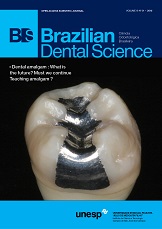Intra pulp chamber temperature variation caused by Nd:YAG and Diode LASER irradiation
DOI:
https://doi.org/10.14295/bds.2015.v18i1.1086Resumo
Objective: Neodymium (Nd:YAG) and Diode LASER irradiation on adhesive systems canincrease bond strength to dentin, however, concerns about the temperature variation inside pulp chamber still remain. The aim of this study was to evaluate the intra pulp chamber temperature variation caused by irradiation with Nd:YAG or Diode LASER on different adhesive systems. Material and Methods: This study presented experimental design with two factors: LASER on two levels (Diode [D] and Nd:YAG [N]) and adhesive system on four levels (Adper™ Scotchbond™ Multi-Purpose [MP], Adper™ SingleBond 2 [SB], Clearfil™ SE Bond [CSE] and Adper™ Easy One [EO]). The quantitative response variable was the temperature variation (?t) in C. Forty bovine teeth, distributed into 8 groups (n = 5), had the buccal surface flattened up to1 mm thickness of dentin. After the application of each adhesive system, but previously to the light curing, specimens were irradiated with Nd:YAG or Diode LASER with standardized parameters. The ?t was obtained through a thermocouple inserted into pulp chamber. The values of ?t were submitted to two-way ANOVA, followed by Tukey (p < 0.05) for individual comparisons. Results: The means (± standard deviation) of ?t were: N-MP: 12.60 (± 2.51), N-SB: 10.40 (± 5.03), N-CSE: 11.80 (± 5.12) and N-EO: 10.20 (± 2.39), D-MP: 4.4 (± 1.82), D-SB: 5.20 (± 1.54), D-CSE: 4.60 (± 1.14), D-EO: 3.60 (± 1.52). Conclusion: The type of adhesive system was not significant in temperature changes generated by LASER irradiation, but Nd:YAG LASER may provide a higher potential to cause pulp damage.
Downloads
Downloads
Arquivos adicionais
Publicado
Como Citar
Edição
Seção
Licença
TRANSFERÊNCIA DE DIREITOS AUTORAIS E DECLARAÇÃO DE RESPONSABILIDADE
Toda a propriedade de direitos autorais do artigo "____________________________________________________________________" é transferido do autor(es) para a CIÊNCIA ODONTOLÓGICA BRASILEIRA, no caso do trabalho ser publicado. O artigo não foi publicado em outro lugar e não foi submetido simultaneamente para publicação em outra revista.
Vimos por meio deste, atestar que trabalho é original e não apresenta dados manipulados, fraude ou plágio. Fizemos contribuição científica significativa para o estudo e estamos cientes dos dados apresentados e de acordo com a versão final do artigo. Assumimos total responsabilidade pelos aspectos éticos do estudo.
Este texto deve ser impresso e assinado por todos os autores. A versão digitalizada deverá ser apresentada como arquivo suplementar durante o processo de submissão.




























